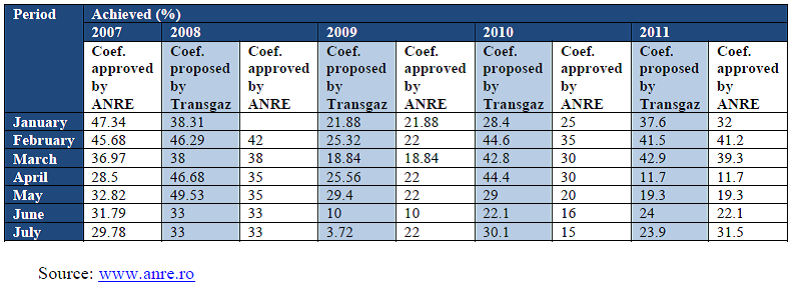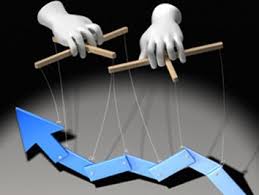Gas market manipulation
The natural gas market liberalized since 2001 has repeatedly gone through manipulative interventions from market players, representatives of some institutions, and last but not least from the authorities. These market manipulations have always yielded important commercial advantages to some companies in the market and never benefited end-consumers.
The first manipulation of the gas market was initiated by authorities in 2007, since when the population had to purchase imported gas, by setting a monthly domestic-import gas basket, established administratively. Analyzing the administrative method for determining the monthly import percentage, it can be observed that over time the gas basket has varied very much, even during the same month, in different years, which apparently is difficult to understand because the demand at a month level cannot show significant variations in different years, except in some special situations caused by market manipulation. These variations were due to the influence of large industrial consumers and large gas suppliers, which in fact made the game on the Romanian gas market, lowering or raising the price of gas for the other consumers through their market behavior, but a behavior legalized by the regulatory authority through specific decisions and orders.
This led to additional payment by the population of a cost higher by 5-15% compared to the Fair Gas Price. The consequence between 2001 and 2012 was that Romania had to pay a price up to 10% higher than the neighboring countries for gas delivered to Romania, as a result of this method.
Following the table below, which contains the import percentage imposed to be purchased by consumers, things are enlightening about the manipulative intervention in the gas market during 2007-2011.
It can be noticed that between the percentage calculated by the Market Operator as actually required on the market and the market share approved by ANRE there are differences, which are not explained by the Authority, but which give economic advantages to some companies (the big industrial gas consumers) and economic disadvantages for other categories in the market.
As a result of the difference between the Market Operator’s calculation and that of ANRE, the actual price was influenced. Indicatively, the variation of the average price on the market by the ANRE’s endorsement of an import gas percentage, other than that calculated as a real demand by the Market Operator, resulted in changes in the average monthly market price between -29% and + 47%.
A second manipulation followed, through Law 332/2009, approving GEO no. 54/2009 on the establishment of temporary measures in the field of natural gas and establishing interruptible capacities in the NTS, determining advantages for only 3 clients (designated by the criteria introduced by the Law 332/2009). In fact, during the period 2008-2010, all consumers, including household, took money out of pocket to subsidize the consumption of 3 consumers. Thus, we have an increase in the average market price by up to 10%.
A third manipulation followed, in 2009, when the notion of deferred costs for regulated consumers was introduced. Respectively, the Authority recognized the gas acquisition prices of suppliers, but these costs were transferred to end-consumers in the following years, with payment to suppliers of a fair compensation in the form of interest.
On 15 September 2012, under an ANRE President Order, ANRE increased the price of natural gas for household consumers by 5%, the explanation being – “to cover the deferred costs from the previous years” for gas suppliers. On 25 October 2012, at a symposium, ANRE representatives showed that this process had to continue until the recovery of half a billion euros by these distribution operators, only for the period 2009-2012. Apparently everything is fine, but if we analyze we will see that a number of industrial consumers benefited from a lower price during the period 2009-2012, while the payment of these additional costs, of RON 9.3 per MWh consumed for 2 years, was made only by the household and assimilated consumers. Thus, some consumers (smart guys) benefited from a low price for 3 years and subsequently the price difference that they should have paid was paid only by the household and assimilated consumers. Thus, we have an increase in the average market price by up to 9.5%.
In 2016, there was an action of manipulation of the gas market through statements of ANRE President, who went public and advised gas consumers to buy imported gas because it was cheaper. Although gas imports went up 629%, the result was not felt in the citizens’ pockets
2017 brings accusations of market manipulation by OMV PETROM, by through the hoarding of quantities. By following the transactions on the gas exchanges, which are mandatory only within 30% of the sold quantity, it can be deduced that there are few transactions in the summer months with delivery in the winter months by this company through the exchanges and we can accept the assumption that the direct gas sales during months with high consumption will bring price increases due to the interaction between supply and demand, but there is also the assumption that the elimination of some intermediaries and direct sale to end-consumers will not bring a change in the price to the end-consumer but will affect the profit of intermediaries.
But we have legal provisions in Law 123/2012, as amended by GEO 60/2016, which set out how transactions can be performed: in conditions of transparency, competition and non-discrimination.
Why don’t we want to apply the law?
Perhaps because the Romanian gas market is full of manipulators manipulating the price of natural gas and they should be uncovered! Perhaps because there are speculators who make important margins and their names would come out! Perhaps because some activities need to be protected!
It is possible that OMV PETROM’s action does not affect so much the price to the end-consumer as the margins of some suppliers.
Translation from Romanian by Romaniascout.
Image courtesy of asociatiaenergiainteligenta.ro.




Recent Comments